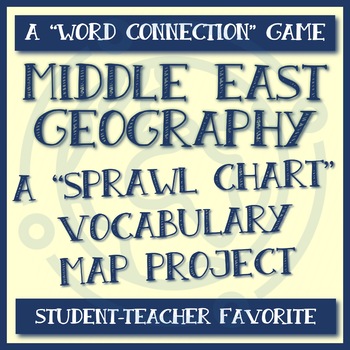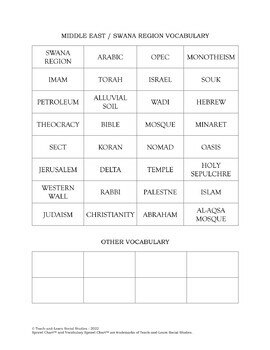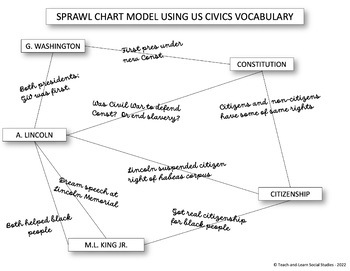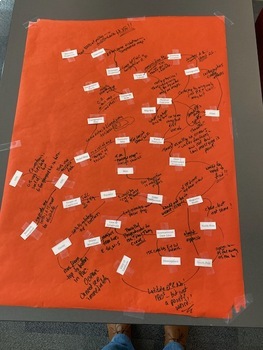MIDDLE EAST CULTURE and GEOGRAPHY -- CREATIVE VOCABULARY CONNECTIONS MAP PROJECT
- Zip
Also included in
- Vocabulary -and sometimes LOTS of of vocabulary-- is an important parts of many social studies and world geography classes.But learning all that vocabulary can shift to memorization and away for real learning. That is why smart teachers look for a way to make learning all of that vocabulary more fuPrice $8.00Original Price $10.00Save $2.00
Description
Middle East / North Africa culture and geography can be "vocabulary heavy" --and teachers often look for a way to make learning all of that vocabulary more fun. How about a creative and engaging "Sprawl Chart"?
Teach-and-Learn's "Sprawl Charts" are an exciting new way for students to make vocabulary connections which drives learning, retention, and engagement.
This project is a "turn key" project --all the teacher has to provide is scissors, tape or glue, and a large piece of paper. This project already has the student vocabulary, student instructions, teacher instructions, a materials list, and a model project all in an easy-to-print format.
And, since different teachers different vocabulary, this product also has ample space for teachers to add their own vocabulary to ensure that all content is covered.
Are there some words you do not teach? No problem! Just put a line through them so that students know not to do them. Or, even better, just circle them as optional "challenge words."
Here are the "pre-loaded" words:
SWANA REGION
ARABIC
OPEC
MONOTHEISM
IMAM
TORAH
ISRAEL
SOUK
PETROLEUM
ALLUVIAL SOIL
WADI
HEBREW
THEOCRACY
BIBLE
MOSQUE
MINARET
SECT
KORAN
NOMAD
OASIS
JERUSALEM
DELTA
TEMPLE
HOLY SEPULCHRE
WESTERN WALL
RABBI
PALESTNE
ISLAM
JUDAISM
CHRISTIANITY
ABRAHAM
AL-AQSA MOSQUE
--
Here's how a Sprawl Chart works (see the preview, too):
1) Pre-teach the vocabulary that students will put on the Sprawl Chart, perhaps from a slide deck. Pre-teaching is strongly recommended. Experience shows that engagement and learning are much higher when all Sprawl Chart vocabulary has been taught in advance.
2) The teacher forms group of two to four students who sit together, ideally with a generous sized work space. Three students works great for group but two also works for older or more advanced students and can four can work in a pinch.
3) The teacher hands out the “base paper” (a large square piece of light-colored roller paper; two 8.5” x 11” taped together are okay though not ideas) and the sheet with the vocabulary to be included on the Sprawl Chart.
4) Students cut out each word so that each word is on its own little rectangle of paper.
5) The teacher MODELS how to connect the words creating the Sprawl Chart. The steps for creating the Sprawl Chart are:
a. Choose one word and tape it to the middle of your base paper.
b. Make a connection to one other word from your vocab list...
(The connection can be serious or very silly. For instance, you could connect Abraham Lincoln and George Washington by noting that they were both presidents; or, you could note the silly connection that they are both on Mount Rushmore!)
...and tape the second word near the first word, draw a line between the two words, then write in the connection between the two words.
c. Choose a third word and think of a connection to EITHER the first word OR the second word. Draw a line that connects the current word to the first or second word already on your paper write in the connection on top of the line.
d. Keep adding and connecting new words until you are out of words.
6) Students COMPLETE THEIR PROJECTS.
7) Students SHARE their top two or three favorite connections with the rest of the class.
--
Would you like to follow Teach-and-Learn?
CLICK HERE!






